Every worker is entitled to go to work and return home safely.Worksafe
The building and construction industry can be a dangerous place to work.
However, most workplace incidents can be prevented with a bit of common sense and some good planning with regular inspection procedures. Worksite practices and processes shouldn't just be about meeting requirements. Health and safety need to be considered every day, during every task, on every project. The most important health and safety tool you have at your disposal is your judgement and the judgement of your team.
The construction industry is known for being one of the most dangerous fields; here are some alarming statistics on fatalities and injuries.
Diagram one: Non-fatal work-related injuries
The first diagram shows the stark comparison between the construction industry and many others. The risk management process is to identify the hazards and determine what causes harm and how to prevent them.

Work-related injuries: Injuries covered by ACC as determined by the Accident Compensation Act 2001 using dataset provided here.
Diagram two: Fatal work injuries
The second diagram looks closer at the fatalities within the year from Jul 2022 to Jun 2023.
Work-related fatalities are deaths that occur as a result of injury from work. This data includes workers who die from injuries while working and members of the public who die as a result of someone else’s work activity. It excludes deaths from natural causes and self-harm. The data cannot include deaths from occupational disease (see work-related health). This is a single work-related fatalities dataset, combining notifications to WorkSafe and data from other agencies. It provides a whole-of-system picture of New Zealand’s health and safety performance.
What can we do?
While the construction industry is risky, proper safety and health training, regular inspections, and equipment checks can lessen some risks.
Working in your team to eliminate safety hazards associated with falls, falling objects and vehicles can save companies hundreds of dollars annually. These are beneficial for keeping workers safe, resulting in being able to go home after a hard day’s work.
This site-safe factsheet provides some key information about the growth of the construction sector in New Zealand. But, with growth comes potential risk. These pressures put on workers potentially increase the risks to health and safety.
We must make ourselves aware of the legislation that affects us and do our best to follow it. This is especially important in fields such as construction, where people may be harmed, and damage caused to buildings due to our actions or inactions. We should look upon it as a way of protecting ourselves and our clients from future harm.
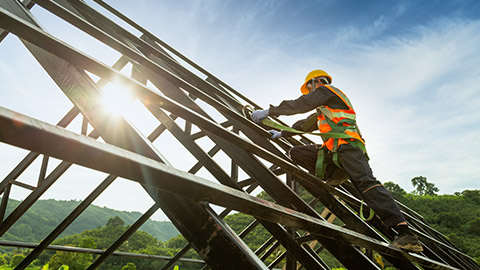
As a rule, if it is done legally, we can be sure it is done and carried out correctly. The primary objective of the Health and Safety at Work Act is to promote the prevention of harm to all persons at work and other persons in the vicinity of a place of work, this means the act is meant to stop employees and public from being injured in any New Zealand workplace.
The legislation and its regulations cover the health and safety of people in all types of workplaces while they are at work. It makes requirements for:
- asbestos
- hazard identification and their control
- general risk of workplace management
- work involving hazardous substance
- training and supervision
- providing safety information
- emergency procedures
- establishing correct duties and responsibilities of parties involved with the work.
The following diagram shows how the Health and Safety at Work Act relates to other regulations and guidelines.
Who regulates this?
Worksafe replaces what was referred to as Occupational Health and Safety and the Department of Labour (OSH). Worksafe is a Crown entity, meaning it is a standalone entity and not part of any other government Department.
Responsibilities according to the Act
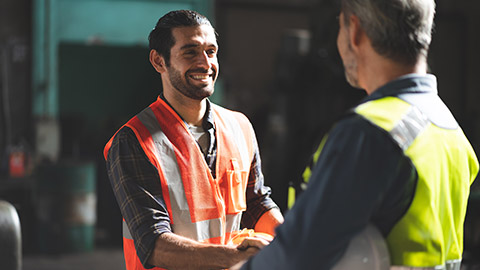
The PCBUs
A PCBU (Person Conducting Business or Undertaking) is not usually an actual person (it is a legalism referring to a business entity). In most cases, the PCBU will be the business itself, like a company or an organisation such as your employer, the main contractor, client or consultant.
The PCBU has the primary duty of care to ensure the safety of workers and anyone else affected by its work.
The PCBU must (as far as reasonably practicable):
- Provide and maintain a workplace that is without risks to health and safety.
- Provide and maintain safe plant and structures and safe systems of work.
- Ensure the safe use, handling and storage of plants, structures, and substances.
- Provide adequate facilities for the welfare of workers.
- Provide information, training, instruction, or supervision necessary to protect all persons from risks to their health and safety arising from work.
What is reasonably practicable?
The Health and Safety at Work Act uses reasonably practicable as the test to determine what is or was able to be done by a PCBU to meet its health and safety obligations. In other words, this means what could reasonably be done at a particular time to ensure health and safety, taking into account and weighing up all relevant associated matters.
The Officers
The people in senior positions significantly influence how the business is run. They include CEOs, directors, sole-charge owner-operators and anyone else at that particular level.
A person who merely advises or makes recommendations to someone in a senior position is not considered an officer. Officers are now personally liable under the Act if they fail to meet their due diligence obligations.
Due diligence
Cambridge Dictionary defines due diligence as an action considered reasonable for people to be expected to take to keep themselves or others and their property safe.
An officer must exercise due diligence by taking reasonable steps to:
- Keep up to date about work health and safety matters.
- Understand the nature of the hazards and risks associated with the organisation’s operations.
- Ensure the organisation has resources and processes to eliminate and minimise risks.
- Ensure appropriate and timely processes for receiving and responding to incidents, hazards, and risks.
- Ensure there are processes for complying with any duty.
- Verify that health and safety processes are in place and being used.
The Workers
The workers are also known as the employees.
Workers are individuals who carry out work for the PCBU. Workers should take reasonable care to ensure the health and safety of themselves and others in the workplace.
- Follow instructions from the PCBU.
- Cooperate with health and safety policies and procedures of the PCBU.
- Workers also have the right to refuse to undertake unsafe or dangerous work.
Most construction sites have health and safety representatives knowledgeable about health and safety matters. They are aware of the rights and responsibilities of everyone in the workplace. If your company has an elected health and safety representative, make sure you know who that person is, as you can go to them for advice if something concerns you.
Reading
More information on the roles and responsibilities can be found on pages six to nine of this SiteSafe practical guide.
Hazard
A hazard is anything that has the potential to cause harm.
There are a number of potentially hazardous situations, equipment, activities, tools, and materials on a building site. One in every ten construction workers perceive a risk of serious injury on site. Most injuries caused by hazards can occur from body stress, falling from heights, slipping and trips, or using power tools. Hearing loss is also very common among on-site workers. There are also hazardous materials around the site that can be responsible for respiratory and other health-related problems with our workers.
Hazards fall into three main types, these are:
- Biological: Bacteria, micro-organisms and viruses can reside in or be transferred.
- Chemical: Manmade substances that can cause illness and harm through mishandling or processing.
- Physical: Poor practices around standards which can cause harm to ourselves or others
Health and Safety Plan and Risks
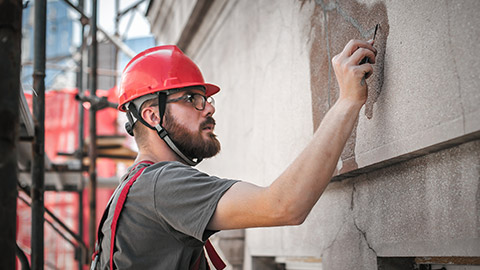
A health and safety plan must be prepared for commercial or multi-unit construction project. It is the duty of the project site manager, or employer, to identify and minimize the risks, provide necessary safety equipment, and notify workers and visitors to the site of any potential risks. This is to ensure that health and safety are managed and that proper ways of controlling hazards are implemented.
A site safety checklist should cover amenities and facilities such as:
PPE (Personal Protective Equipment)
All workers or visitors on site should be provided with personal protective equipment (PPE), be trained in its use and be aware of the reasons for its use. If required, your site safety checklist should also include things like:
- Consideration of prevention from falling.
- Electrical safety consideration.
- All important safety hazardous substances handling and portable equipment or material handling requirements.
The most effective method to ensure that risks and hazards are covered is to implement a Site-Specific Safety Plan (SSSP).
Each contractor or employee develops this plan on-site to document how to manage safety. It describes how safety activities will be coordinated, communicated, and monitored and how specific hazards will be controlled.
What needs to be in a safety communication plan?
- The name of the subcontractor who developed the site-specific safety plan and the main contractor
- The name of the company site safety representative who has authority for safety
- Any notable work being undertaken
- The hazard management process is being used
- Any hazardous substance is to be brought on-site
- The method of involving employees
- Emergency plans and procedures
- Accident reporting and investigation procedures
- Safety inspection and reviews
- Training and induction activities
Reading
Detailed information about PPE can be found on Worksafe PPE page.
More in depth explanation on these Site Specific Safety Plans can be found in the Auckland Council - Site Safety Plan.
Further information on getting the most from your SSSP can be found in these Plain Safe Guides that are right for you from Site Safe New Zealand.
Toolbox Talks
A toolbox talk is a discussion, normally from ten to fifteen minutes long, on-site, on how to do a specific job and how to do it safely.
Also known as a Pre-Start or Health and Safety Meeting, Toolbox Talk is a way of communicating these required health and safety matters. These meetings are recommended by SiteSafe to be held regularly onsite and around the workplace. Some businesses undertake Toolbox Talks at the start of every day, while others hold them every one or two weeks or before new work starts. Regardless of their frequency, the important thing is that they happen, and the focus is on safety.
A few useful tips from SiteSafe for running your Toolbox Talks are:
- Arrange a suitable meeting location; actively involve the workers for input.
- Use props and visual aids; review your task breakdown analysis.
- Talk about problems or incidents.
- Recognise safe performance.
- Encourage feedback.
Explore
Watch: Manual handling (4:40 seconds)
This video provided by HASpod illustrates an example of a Toolbox Talk that could be carried out on manual handling on site.
Risks
What is risk?
Risk arises from people being exposed to a hazard (a source of harm).
The level of risk is determined by the combination of:
- the likelihood of a hazardous event occurring
- the severity of the injury or illness.
Risk management
Risk management is the process of identifying hazards.
To minimise the hazards and risks, site managers or others in a construction site should prepare a safety plan or checklist. To manage risks, all PCBUs are required to identify any reasonably foreseeable hazards that give rise to health and safety risks to their employees or workers. The level of the risk for each hazard must then be assessed. Once assessed, implement controls to eliminate or minimise these risks and monitor the effectiveness of these controls.
What does a risk assessment involve?
Assessing the risks involves identifying the hazards that exist and assessing the impact of the identified hazards on those who work in the area. When assessing the risk, you determine the likelihood that the hazard may lead to injury and disease. PCBUs and supervisors have a duty to conduct risk assessments to ensure protection against potential hazards on sites. Conducting risk assessments is fundamental to preventing and reducing injuries.
Risk assessment matrix
A risk assessment matrix is a handy tool for figuring out and prioritising risks by looking at how likely something is to happen and how bad it could be if it does. Imagine a grid where one side shows the chance of something going wrong (likelihood), and the other shows how serious the impact would be (consequences).
To use it, you simply find where the likelihood and impact of a risk meet on the grid. This spot will show you the risk level, usually colour-coded for easy reading: green for low risks, yellow for moderate, and red for high risks. By mapping out risks like this, it helps you see which ones need urgent attention and which ones can be watched over time. It's a great way to keep things safe and organised on your project.
| Likelihood | ||||||
|---|---|---|---|---|---|---|
| Rare | Unlikely | Possible | Likely | Almost certain | ||
| Consequences | Major | Moderate | High | High | Critical | Critical |
| Significant | Moderate | Moderate | High | High | Critical | |
| Moderate | Low | Moderate | Moderate | High | High | |
| Minor | Very low | Low | Moderate | Moderate | Moderate | |
| Insignificant | Very low | Very low | Low | Moderate | Moderate | |
For example, a tripping hazard occurs when an extension cord is placed across an on-site area, however, may be low or high, depending on several factors. The risk may be low if no one ever walks in that area. The risk may be high if any one of the following is present:
- the area is used frequently,
- the lighting in the area is poor,
- and/or there are no warning signs or devices to indicate there is a hazard.
Control measure
A control measure is any measure taken to eliminate or minimise risk.
Once hazards are identified and risks are assessed, the risks need to be controlled or eliminated effectively. When controlling most hazards and risks, the better the controls used, the lower the level of risk.
This is then called the Hierarchy of Control Measures. This hierarchy system associated with control measures, minimises hazards and potential risks. It works because when minimising a hazard, the controls higher on the list are more effective in managing those related risks.
| (S) Substitution controls | Example: Using a different chemical that is not as toxic as another or a different building material. |
|---|---|
| (I) Isolation controls | Example: Barriers that keep workers and hazards apart. Separation is another word to use as a method of isolation. |
| (E) Engineering controls | Example: Sound enclosures around loud plant machinery or an airborne extraction system such as fans and ducting that remove hazardous vapours from a combined or enclosed space or room. |
| (A) Administrative controls | Example: Conducting training, implementing policies and procedures, putting up signs and visual warnings. |
| (PPE) Personal Protective Equipment | Example: The gear and clothing you wear as the first line of defence. |
~Worksafe New Zealand
The risk management process is to identify the hazards and determine what causes harm and how to prevent them.
- (S I E) Situation, Isolation, and Engineering controls are most effective when minimising a risk.
- (A PPE) Administrative and PPE control should be used with other controls further up the hierarchy.
- Controls may involve just a single measure or a combination of different measures that, when together, provide the highest level of protection that is reasonably practicable.
Let's look at the following case study to put into practice what we've learned so far.
Reading
Site Safe New Zealand has produced a Passport Handbook, a great online resource library on all these risk management strategies, which will be provided at the end of this short video.
Site Emergency Procedures
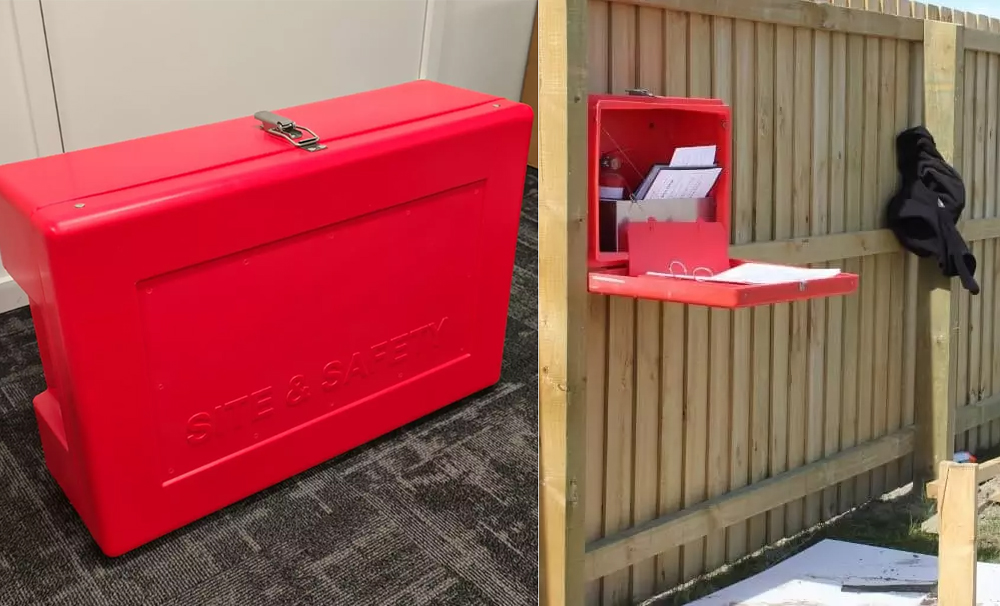
An example of a site safety box required to be installed at every worksite from sitesafety.co.nz
Commercial construction projects in New Zealand typically use site safety boxes. These safety boxes, also known as first aid or safety stations, are essential for maintaining health and safety on construction sites.
PCBUs have a duty to provide first aid for their workers at work. These boxes contain first aid kits, personal protective equipment (PPE), safety data sheets (SDS), and emergency contact information.
First aid supplies are the essentials that should be easily accessible and checked. When an injury or accident occurs, workers should always:
- Seek immediate first aid treatment.
- Know where the first aid facilities are and who to contact.
The first aid kit's contents should be placed in a weatherproof container with individually sealed packages for each type of item. It needs to be checked by the employer at least once a week on each job to ensure that the used items are replaced.
Site safe passports/Constructsafe cards
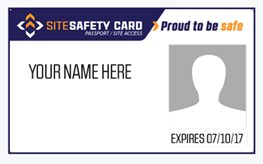
A Site Safe Passport (also known as a Site Safe Construction Passport or Site Safe Card or in Australia a “White card”) is a certification card issued to those who have completed a basic Site Safe course to improve health and safety practices in the construction industry.
These forms of Site Safe Card/Passport are typically required for workers to gain access to commercial construction sites across New Zealand, this ensures that all personnel have a basic understanding of safety requirements and regulations. It is part of a broader effort to reduce accidents and injuries in this sector.
Site safety box
Job site first aid equipment is a legislated requirement, and employees should be aware of their kits and locations. A PCBU must not impose a levy or charge on a worker for anything done or provided about health and safety, including providing first aid kits and facilities.
If a fellow team member is seriously injured, find a qualified first aider present on site.
All team members need to know how to deal with different types of emergencies and keep a current first aid certificate to provide the first level of treatment. Organise a refresher course regularly to maintain currency.
To call or not to call

In an emergency, call 111.
You or a construction team member might hesitate to call 111 for an ambulance for fear of making a scene or embarrassment.
When someone is injured, there's always a risk of under-assessing the severity of the injury. If in doubt, ask for an ambulance, and the helpline team will talk you through the necessary assessment steps. An ambulance will be dispatched immediately; most of the time, the light and loud sirens will not be turned on. They are only turned on when attending a life-threatening emergency or taking a critically ill patient to the hospital.
Calling an ambulance instead of bringing an injured person to the Emergency Department (ED) yourself offers several advantages:
-
Immediate medical assistance: Paramedics provide crucial medical care at the scene and during transport, which can stabilise the injured person and potentially save their life.
-
Specialised equipment: Ambulances are equipped with medical tools and medications unavailable in a personal vehicle, allowing for better immediate care.
-
Safe transport: Paramedics are trained to move and transport injured individuals safely, reducing the risk of further injury.
-
Traffic and accessibility: Ambulances have priority on the road and can navigate traffic more effectively, ensuring quicker arrival at the hospital.
-
Direct communication: Paramedics can communicate directly with the hospital en route, ensuring the medical team is prepared for the patient’s arrival.
-
Legal and liability protection: Using professional medical transport reduces the risk of legal and liability issues that might arise from transporting an injured person in a private vehicle.
St. John's Ambulance charges $98 as of May 2024 for a call-out and it will be billed to the patient by post in the following weeks. New Zealand's healthcare system covers the cost of treatment for accident injuries, so there's no need to worry about footing the bill yourself.
Ensure that the person in charge of the site on the day remembers to make a note in the accident register when things have settled down. This note will be invaluable when ACC (Accident Compensation Corporation) needs to do an assessment of any future claims.

Government legislation and rules relating to workers' wellbeing are essential for creating a fair, safe, and supportive work environment for all on-site personnel, that benefits both themselves and the employers. These bills or acts of parliament are put in place to contribute to a healthy organisational culture and foster a positive relationship between employers and their workforce.
Implementing company strategies to promote psychological wellbeing and reduce the stigma surrounding mental health will support employees facing these challenges.
Remember, workplaces and the staff working in them can create healthier and more productive work environments while supporting each employee's wellbeing.
These particular New Zealand bills are crucial for several reasons:
- Reducing employee turnover and absenteeism
- Protecting workers' rights: Workplace regulations ensure employees are treated fairly and ethically. These laws often cover minimum wage, working hours, overtime pay, and leave entitlements, safeguarding workers from exploitation.
- Ensuring safety and health: Workplace safety regulations are designed to protect employees from all hazards and ensure a safe working environment. The Act recognizes that the health and safety of workers encompasses both physical and mental health.
- Promoting mental health: Legislation may also address mental health issues in the workplace. Rules around stress management, harassment prevention, and reasonable accommodations for mental health conditions contribute to a healthier work environment.
Employment New Zealand
Protection of an employee's personal information regarding their wellness health condition is a core principle of many company procedures.
This privacy law covers personal information, communication, activities, and belongings that pertain to the employer-employee relationship. Employee privacy in New Zealand is governed by law, so company policies must comply with its regulations. These regulations specify what monitoring, surveillance, and access to personal information employers are allowed to have.
It is mandatory for employers across all industries to maintain confidentiality of their employees' wellness and health-related information, both legally and ethically. Only individuals with a legitimate need to know should have access to this confidential information. In a position of authority, this information should be handled with care to prevent unauthorised disclosure to others.
Remember, employees cannot be treated unfairly or discriminated against due to their mental or physical health conditions under New Zealand privacy laws.
Reading
More information pertaining to employment in New Zealand can be read on the Employment New Zealand website.
Employment Relations Act 2000
This act governs the employment relationship and includes provisions related to collective bargaining, dispute resolution, and the rights and obligations of both employers and employees.
The Employment Relations Act 2000 in New Zealand plays a crucial role in promoting workers' wellness on all construction sites. This is done by establishing fair employment standards for all workers, providing dispute-resolution mechanisms, and supporting collective bargaining and representation.
This piece of legislation supports wellness on a construction site for several reasons, including:
- Collective Bargaining: Collective bargaining is allowing workers to negotiate employment agreements collectively. This empowers staff members to have a collective voice in discussions about wages, working hours, and other conditions, contributing to better working conditions and overall wellness.
- Minimum Employment Standards: This Act sets out minimum employment standards, including provisions for minimum wage, working hours, breaks, and leave entitlements.
- Protection Against Unfair Treatment: The Act protects unfair treatment, including unjustified dismissal or disadvantage. This protection is essential for construction workers, as it ensures they can raise concerns about workplace safety or other issues without fear of retaliation, contributing to a safer and more transparent work environment.
- Provisions for Collective Disputes: In the construction industry, where disputes may arise over various issues, the Act provides mechanisms for resolving collective disputes. This helps maintain a stable working environment, reducing stress and promoting overall wellness among construction workers.
Reading
Read the Employment Relations Act 2000 in full on the legislation New Zealand website.
Human Rights Act 1993
Human rights are the basic rights and freedoms we are all entitled to, no matter what our age, ethnicity, culture, religion or sex. Unlawful discrimination occurs when a person is treated unfairly or less favourably than another person in the same or similar circumstances
The Human Rights Act 1993 is important for all workers' wellness, whether on a construction site or not. It provides a legal framework to protect and promote fundamental human rights. While the Act doesn't explicitly address workplace conditions or safety, it does establish principles that indirectly contribute to workers' wellbeing, physically and mentally.
Reading
Read the Human Rights Act 1993 in full on the legislation New Zealand website.
Health And Safety At Work Act 2015
This legislation aims to prevent harm to workers and others by managing risks and ensuring a safe working environment. It outlines the duties of employers, workers, and others to achieve this goal.
This particular Act recognises that the health and safety of workers encompasses both physical and mental health. It places a duty on employers to ensure the health and safety of their workers, including taking steps to prevent harm to their mental health.
Specifically, the Health and Safety at Work Act 2015 includes provisions related to managing workplace stress, preventing bullying and harassment, and promoting a positive work environment. Employers are required to identify and manage risks to workers' health and safety, including addressing factors that may impact mental health.
Some key aspects related to mental health in the Act include:
- Duty of Care: Employers have to ensure the health and safety of workers while at work. This duty extends to both physical and mental health.
- Risk Management: Employers are required to identify and manage risks to the health and safety of workers, which includes assessing and addressing factors that may contribute to stress or other mental health issues.
- Consultation and Participation: The Act emphasises the importance of involving workers in health and safety matters, including discussions about potential risks to mental health and strategies for prevention.
- Bullying and Harassment: The Act recognises the importance of preventing and addressing bullying and harassment in the workplace, which can have significant impacts on mental health.
Reading
Read the Health And Safety At Work Act 2015 on the legislation New Zealand website.
ISO 45003 Standard
As with most standards used on-site, ISO 45003 is the main global standard and risk management tool that guides how to manage psychosocial risks and promote wellbeing at work.
These psychosocial risks can affect an employee’s psychological response to work and workplace conditions. These potential risk factors can be present in all areas of site construction and can arise from all kinds of work tasks and employment arrangements. Psychosocial risks have the potential to cause various outcomes on health, safety, wellbeing, and organisational performance.
Although, as with other building standards, these standards are not legally enforceable, they do, however, provide a useful framework for complying with the various required duties under the HSWA.
Reading
More information on this standard and others related to construction work can be reviewed on the standards website.
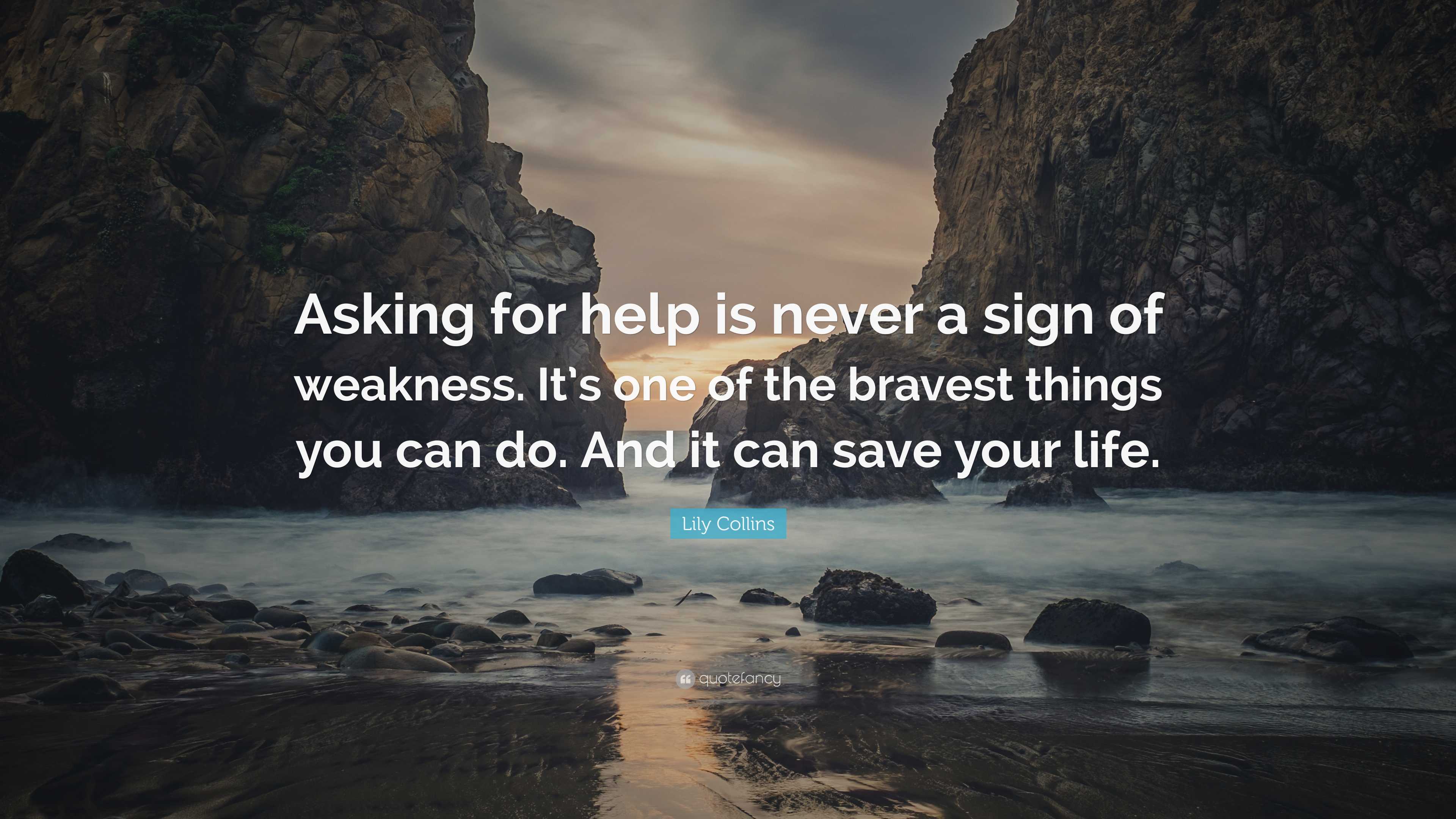
As a supervisor, it's crucial to make reasonable accommodations for your team members. Consider the flexibility you currently have on your building project; sometimes, the same adjustments offered for physical health issues can support other wellness needs.
A wealth of resources, including helplines, websites, and in-person support, are available to provide assistance and information. Government initiatives are also targeting the reduction of suicide rates on construction sites. By having literature about wellness and mental health on-site, you can raise awareness among staff, educate them, reduce stigma, and create a supportive environment.
If company resources are limited, explore what other support may be available for your workers, for example:
- Their close circle (family, whānau, and friends).
- Other people in their lives, such as sports coaches or people that they look up to.
- Community leaders such as church ministers or local kaumatua.
- Community health organisations and their GP (General Practitioner).
- EAPs (Employee Assistance Programmes).
Let's look at some of these support systems in detail.
EAP (Employee Assistance Programme)
Employee Assistance Programme in Aotearoa is an employer-funded initiative designed to offer confidential support services to staff members dealing with personal or work-related problems that might impact their job performance, health, mental wellbeing, or personal life.
EAPs provide a variety of services, including counselling, therapy, and referrals to other resources or professionals. These programs are particularly beneficial in the construction industry, where employees often face challenges such as long hours, high-pressure deadlines, physical strain, and exposure to potentially hazardous environments. These conditions can lead to stress, anxiety, depression, and other mental health issues.
For supervisors in the construction industry, EAPs are a valuable resource. They help support workers dealing with the physical and emotional demands of the job, ultimately enhancing employee well-being, job satisfaction, and overall productivity. By leveraging EAP services, supervisors can create a healthier, more supportive work environment for their teams.
Organisation Support
WorkWell is a Toi Te Ora Public Health initiative offering a free, comprehensive workplace wellbeing program tailored to New Zealand workplaces. For supervisors in the construction industry, WorkWell provides valuable resources and tools to create a healthier and more supportive work environment. By integrating WorkWell's strategies, supervisors can enhance employee wellbeing, reduce workplace stress, and improve productivity. The program's focus on practical, evidence-based approaches makes it an excellent fit for the unique challenges faced in the construction industry.
Reading
Visit the website for more information workwell.heath.nz
Self-initiated support

The following digital resources have been provided by Te Whatu Ora | Health New Zealand. Helpline services are readily available in New Zealand to offer support, information, and help for you, your team, and their families. For more information and resources on creating a healthy workplace, including framework templates, visit the links below.
Here are our top three picks for you to explore:
Small Steps is a web app to help you maintain wellness with easy, practical steps you can apply to your daily life.
Headstrong (including Aroha Chatbot) is a uniquely New Zealand chatbot app designed for young people it feels like talking with a trusted friend. Download it from the app store on your mobile device.
Wellbeing Support is an online directory to find free mental health and addiction support near you through the Access and Choice programme.
Construction-specific Initiatives
The following digital resources are construction-specific health, safety, and wellbeing initiatives.
Here are our top three picks for you to explore:
- Worksafe
- Mates in Construction
- CHASNZ - Construction Health and Safety New Zealand
Immediate help
Do you want to talk to someone now?
The following helpline numbers from the Mental Health Foundation Helpline services are available right now in New Zealand. All the services listed here are available 24 hours a day, seven days a week.
Here are our top helplines to get you connected now.
- Free call or text 1737 any time for support from a trained counsellor.
- Lifeline – 0800 543 354 or free text 4357
- Youthline – 0800 376 633 or free text 234
- Samaritans – 0800 726 666
- Suicide Crisis Helpline – 0508 828 865
- Healthline – 0800 611 116
Explore
Watch: Lifeline TVC (30 seconds)
The following clip is a flashback glimpse into one of Lifeline's most memorable television advertisements.
Click ‘Video Transcript’ or the plus icon (+) to expand and reveal the transcript for the previous video.
That's the end of our wellbeing responsibilities module. You have walked through the topics of; promoting and supporting the wellbeing of team, implementing strategies that support the statutory provisions, exploring good practices for responding to indicators of negative change in mental health. Remember, a healthy workforce is a resilient and productive one. Stay safe, stay well, and let's continue building a brighter, healthier future together in the construction industry.
